For the last six years we have worn and tested the Seiko SKX and the Seiko 5 Sports SKX Series during real-world use. In that time the classic SKX moved from everyday beater to discontinued icon and the Seiko 5 Sports stepped in as it’s more accessible and reimagined replacement. But does the Seiko 5 Sports honor the Seiko SKX’s tool-first, affordable dive watch legacy?

In this Seiko SKX vs Seiko 5 Sports comparison, we’re going to dive into the tangible experience: how they wear, how they perform, and what they cost. The real question is whether they still feel like the same honest, value-first diver watch that made the original SKX a legend.
Overview & Identity
When it comes to the Seiko SKX vs Seiko 5 Sports debate, both watch lines showcase Seiko’s approach to honest, purpose-driven design.

The Seiko SKX has always been more than a watch; it’s a symbol of what affordable dive watches should be. Built to take a beating, the SKX007 we tested hands-on remains a perfect example of Seiko’s no-nonsense design philosophy. At around $200–$300, it’s the kind of diver you can dive with, or simply wear without worrying about scratches, knocks, or rain. Everything about it feels purpose-driven: the grippy bezel, the chunky hands, the reliable 7S26 automatic movement that keeps ticking. There’s a reason so many collectors (ourselves included) have sold an SKX to buy another one later. It’s functional, unpretentious, and honest in a way few watches manage today.

The newer Seiko 5 Sports SKX Series (often called the “5KX”) takes that legacy and moves it into more casual territory. During our time testing the SRPD51, it became clear that this isn’t trying to replace the SKX. Instead, it’s evolving it for everyday wear. The 5KX still carries that classic Seiko diver DNA: the case shape, the bezel cues, the reliability, but trades ISO certification for broader style options and accessibility. It’s a watch that feels just as at home on a NATO strap during the weekend as it does peeking out from under a cuff at work. For newer enthusiasts, it’s an easy entry point. For longtime Seiko fans, it’s a reminder that not every successor has to be a clone.
- The SKX series embodies pure utility: a dive watch built for purpose, refined by decades of iteration.
- The Seiko 5 Sports line embraces flexibility: a daily-wear evolution that keeps Seiko’s spirit alive, even as it changes with the times.
Design & Wearability: Tool Watch Grit vs Everyday Versatility
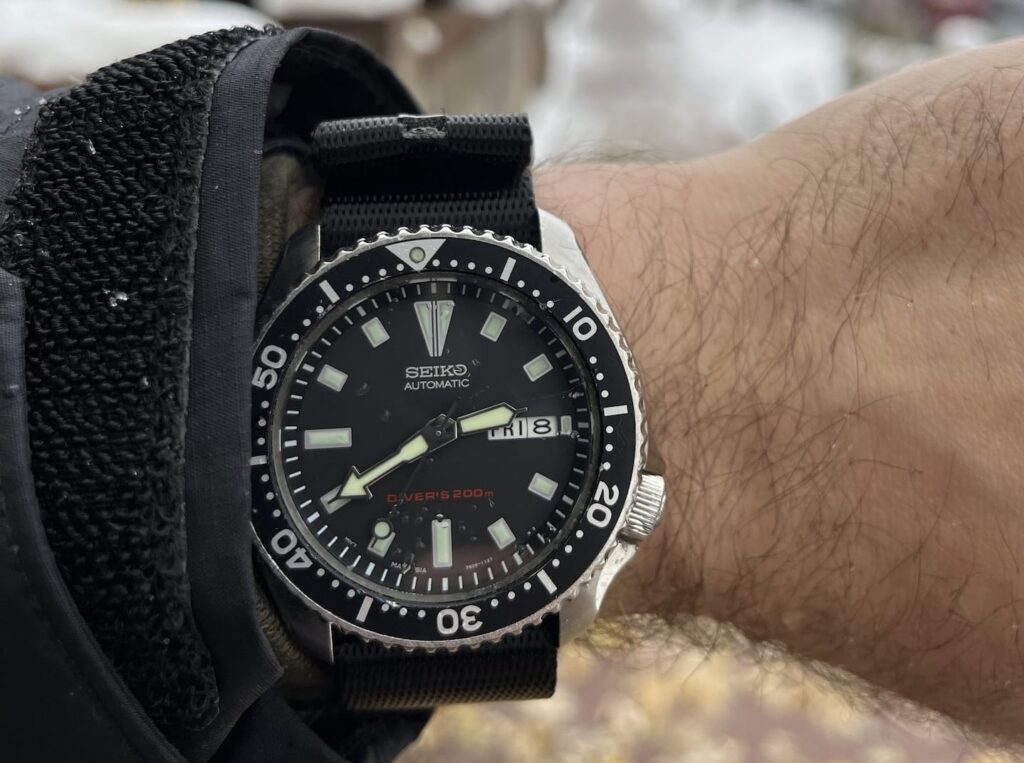
The Seiko SKX has always been about pure function; design that serves a purpose first and earns its charm through use. During our hands-on time with the SKX173, it was immediately clear how that design philosophy plays out on the wrist. The rectangular indices and tall trapezoid marker at 12 o’clock gave it a slightly more military, tool-watch look than the SKX007’s round markers. It is sharper, more utilitarian, and easier to read. The LumiBrite lume is classic Seiko: bright enough to shame other watches twice its price, and still glowing strong after hours in the dark. Even the day-date window, often treated as clutter, feels practical here. When you’re juggling odd hours or deadlines, that glance tells you everything you need to know. The stock rubber strap may divide owners (ours eventually tore after years of wear), but swap it for a NATO, or a jubilee/oyster/beads of rice bracelet, and it becomes a true strap monster: one of those watches that looks right no matter what it’s wearing.

The Seiko 5 Sports, especially the SRPD51, offer a different level of versatility. The sunburst blue dial shifted tone beautifully in different light, subtle and almost slate in shade, vibrant when the sun hit it right. The applied indices and logo add a touch of polish, while the matte blue aluminum bezel keeps things grounded. It’s familiar, yet clearly modernized without the vintage vibe of the SKX. Seiko also made some practical design moves. Seiko now offers the 5KX with far more strap and bracelet choices straight from the factory. The old rattly jubilee and stiff rubber strap are gone, replaced with cleaner, more varied OEM options. Our SRPD51 came on a three-link metal bracelet that’s functional, though not flawless. The folded clasp feels a little cheap, and resizing those pin-and-collar links remains tedious. Still, the 22mm lug width can take nearly any strap you throw at it. On the wrist, it wears flat and balanced, comfortable for long stretches, and perfectly sized for most wrists.
- The SKX stays true to its roots: rugged, legible, and function-first, built for those who care more about reliability than polish.
- The Seiko 5 Sports adds flair and flexibility, proving that everyday practicality and a bit of personality can coexist on the same wrist.
Build Quality & Technical Approach
Both watch lines are built to handle daily wear with ease, but their technical philosophies take different paths.
Movements:

The SKX173 sticks to what made the original Seiko divers so beloved: a no-nonsense automatic workhorse built to last. Inside beats the 7S26 movement, the same one powering the SKX007. It vibrates at 21,600 Hz with about 40 hours of power reserve. It doesn’t hack or hand-wind, and yes, that can be annoying if you rotate watches often. But in our experience, that simplicity is part of its charm. Our SKX173 has gone well over a decade without major service and still runs reliably. Accuracy hovers around –20 to +40 seconds per day, which feels acceptable for a watch in this category. It’s the kind of mechanism that keeps running, no matter how carelessly you treat it. For a tool watch designed for the real world, that level of reliability matters more than perfection.
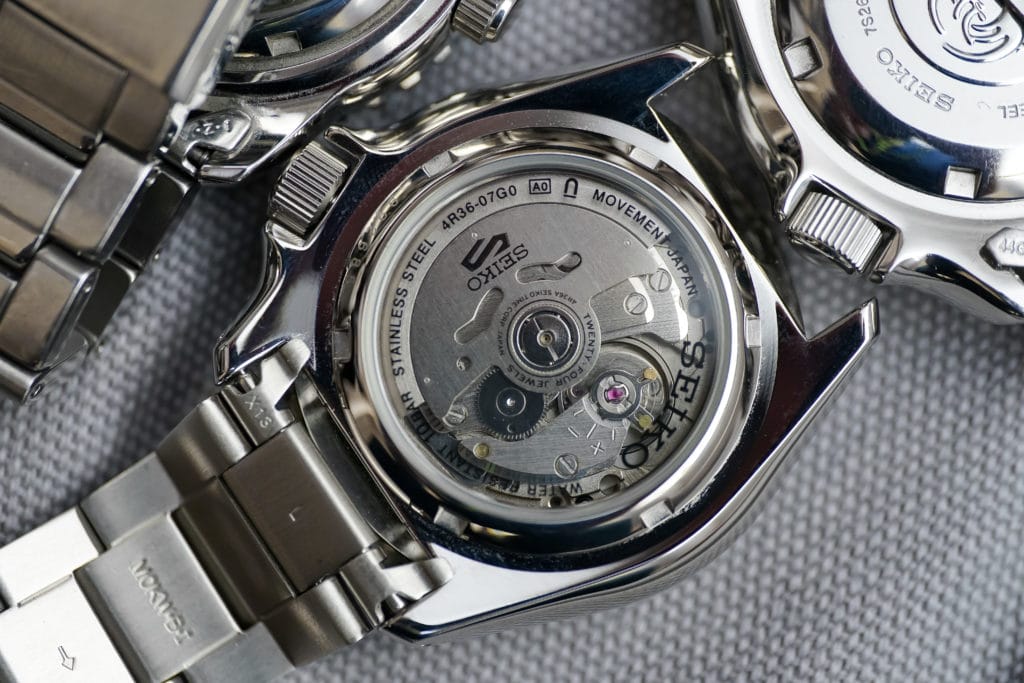
Seiko took a different tack with the 5 Sports line. The 5KX models, along with newer pieces like the Seiko 5 GMT, bring in-house updates like the 4R36 and 4R34 calibers. These movements add hacking and hand-winding, which are small but meaningful improvements for everyday usability. In our time testing the Seiko 5 GMT, the 4R34 proved easy to live with: about 40 hours of power reserve, smooth winding action, and solid timekeeping that stayed within spec. It may not have the fancy local jumping-hour trick seen on higher-end GMTs, but it delivers what Seiko does best: mechanical reliability without pretense.
Case Construction & Finishing:

The Seiko SKX007 embodies everything that made the SKX line a dependable everyday diver. Its 42mm stainless steel case feels solid yet balanced, with Seiko’s signature cushion shape: a design rooted in the 7002 divers. It wears smaller than the numbers suggest, making it a natural fit for most wrists. The 120-click unidirectional bezel isn’t luxury-grade tight, but it’s smooth, positive, and easy to use, whether timing a dive or a lunch break.

The Seiko 5 Sports SRPD51 carries much of that structure but adds modern touches. The case dimensions and 4 o’clock crown placement remain, though Seiko improved grip with light milling. The polished surfaces feel a bit more refined, and drilled lugs make strap swaps quick. That’s a small yet meaningful quality-of-life upgrade. The most significant change is the display caseback, replacing the SKX’s solid steel with Seiko’s movement on full view. It’s fun for newcomers, but it sacrifices a bit of the original’s rugged personality. At roughly 13.5 mm thick, it sits tall but feels balanced and comfortable. The 5KX keeps the familiar shape and solid build while trading a bit of professional dive readiness for versatility and ease of use.
Crystals:
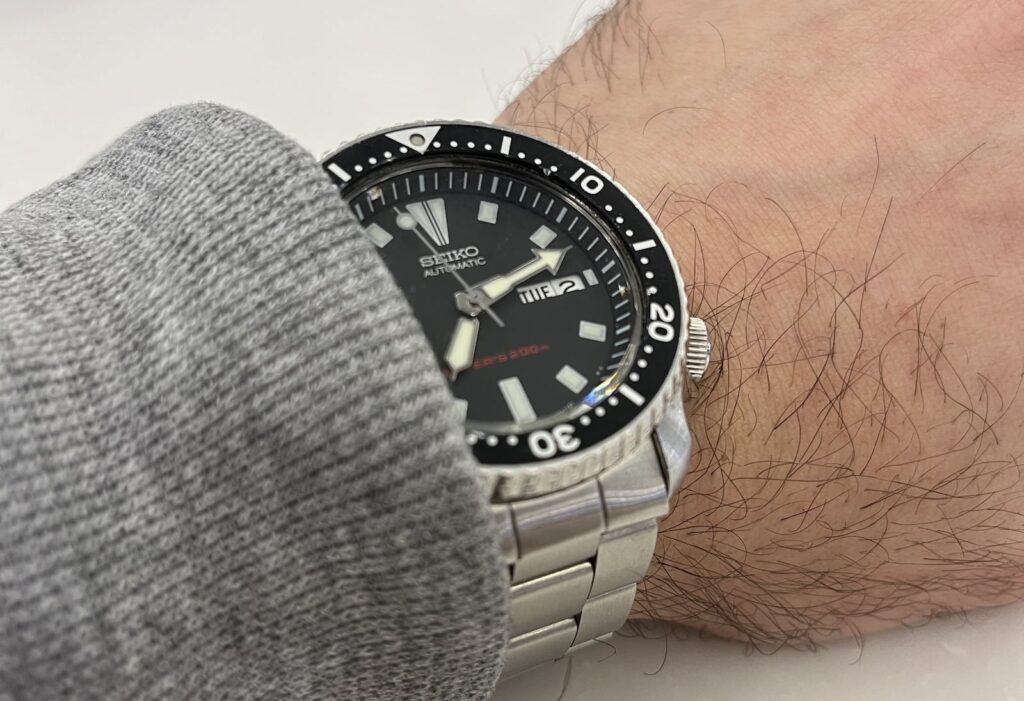
Seiko keeps things practical with both the SKX and 5 Sports lines, sticking to its tried-and-tested Hardlex crystal. On the SKX173, it’s proven tougher than standard mineral glass, though not immune to scratches. Ours showed a few marks from years of use, but the dial remains perfectly legible. It’s also easy and inexpensive to replace, which fits the SKX’s reputation as a modder’s favorite.

The 5 Sports series carries the same approach forward, with Hardlex crystals that feel clear, sturdy, and suited for daily wear. Some models, like the Seiko 5 GMT, add a cyclops magnifier that is handy for reading the date, even if opinions differ on the look. During testing, the crystal handled everyday bumps and heat without issue, maintaining distortion-free clarity. Neither lines opt for sapphire.
Water Resistance:

While testing the SKX173, our review team found that the 4 o’clock screw-down crown kept it comfortable and secure, helping maintain the ISO-rated 200m water resistance. This means that it is truly suitable for diving purposes and should be viewed as a tool first, and anything else second.

The 5KX, on the other hand, loses ISO 6425 certification and swaps the screw-down crown for a push-pull version, making it a “dive-style” rather than a genuine dive watch. However, in our experience, a few pool sessions, showers, and hot-tub tests later, it handled daily splashes fine.
- The SKX series is pure tool-watch engineering. It includes a rugged 7S26 movement, an ISO-rated case, and a Hardlex crystal, built for reliability over refinement.
- The 5KX line modernizes that philosophy with upgraded 4R-series movements, sleeker finishing, and everyday durability that favors versatility over certification.
Cost Considerations

The Seiko SKX vs Seiko 5 Sports price story tells you everything you need to know about their evolution.
Back when you could stroll into a mall and pick up an SKX007 for a couple of hundred bucks, it was the undisputed king of affordable dive watches. Those days are long gone. Since Seiko officially discontinued the SKX line, prices have crept upward, fueled by nostalgia, mod culture, and plain old supply and demand. These days, an SKX173 (the U.S. market version with rectangular indices) can easily fetch $400 to $600 on the secondary market, often matching or even exceeding SKX007 prices, depending on condition and originality. A few years ago, that would’ve sounded ridiculous for what was once a $200 watch.
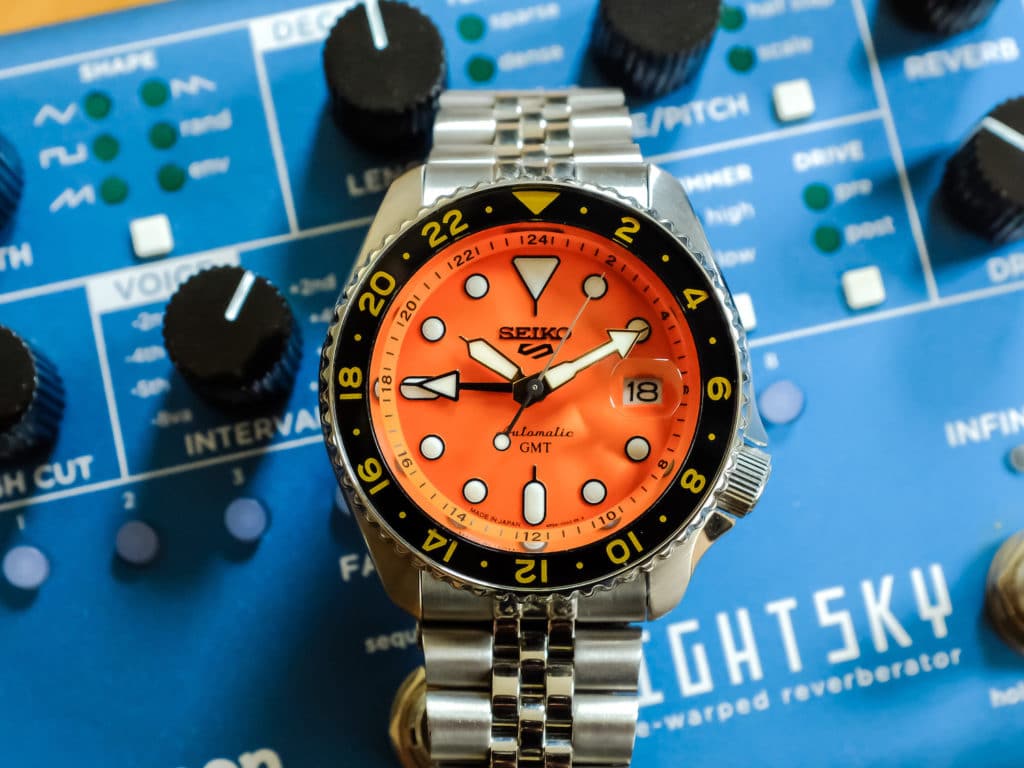
The Seiko 5 Sports SRPD51, by contrast, still lives in the “honest value” end of the spectrum. Ours was snagged online for around $200 after discounts, which feels grounded in a hobby that’s seen so many price hikes. Even Seiko’s newer 5 GMT variant stays attainable at roughly $475 retail. For most buyers, that means you can still get the look, feel, and everyday reliability of a Seiko diver without paying vintage-market premiums.
Final Thoughts: Does the SKX Spirit Live On?
At the end of the Seiko SKX vs Seiko 5 Sports discussion and extensive testing time with both lines, one thing is clear. If you define the SKX legacy as ISO 6425 certification, a screw-down crown, and pure tool-watch toughness at an attainable price, the Seiko 5 Sports does not replace it. The problem is, it’s now a collector’s piece more than an accessible daily diver, with prices that reflect nostalgia as much as performance. However, if you define the legacy of the SKX as honest value, classic Seiko diver DNA, everyday wearability, and broad accessibility, the Seiko 5 Sports keeps that spirit alive to an extent.

The Seiko 5 Sports SKX Series attempts to picks up where the SKX left off, reshaping that toughness into something easier to wear every day. It’s not built to pursue ISO specs or professional dive credentials; it’s about practicality, comfort, and design flexibility. It focuses on practicality, comfort, modern movements with hacking and hand-winding, and a wide range of styles that invite strap a variety of strap combinations.
Who Each Line Is Best Suited For:
- SKX: The purist’s choice; you want the original brief with ISO 200 m, a screw-down crown, and the no-nonsense diver that earned its cult status. You accept secondary-market pricing and prefer heritage over convenience.
- The Seiko 5 Sports: The modern daily; you want an affordable entry with Seiko diver DNA, hacking and hand-winding, lots of variants, and real-world durability without paying collector premiums.

Co-Founder and Senior Editor
Kaz has been collecting watches since 2015, but he’s been fascinated by product design, the Collector’s psychology, and brand marketing his whole life. While sharing the same strong fondness for all things horologically-affordable as Mike (his TBWS partner in crime), Kaz’s collection niche is also focused on vintage Soviet watches as well as watches that feature a unique, but well-designed quirk or visual hook.
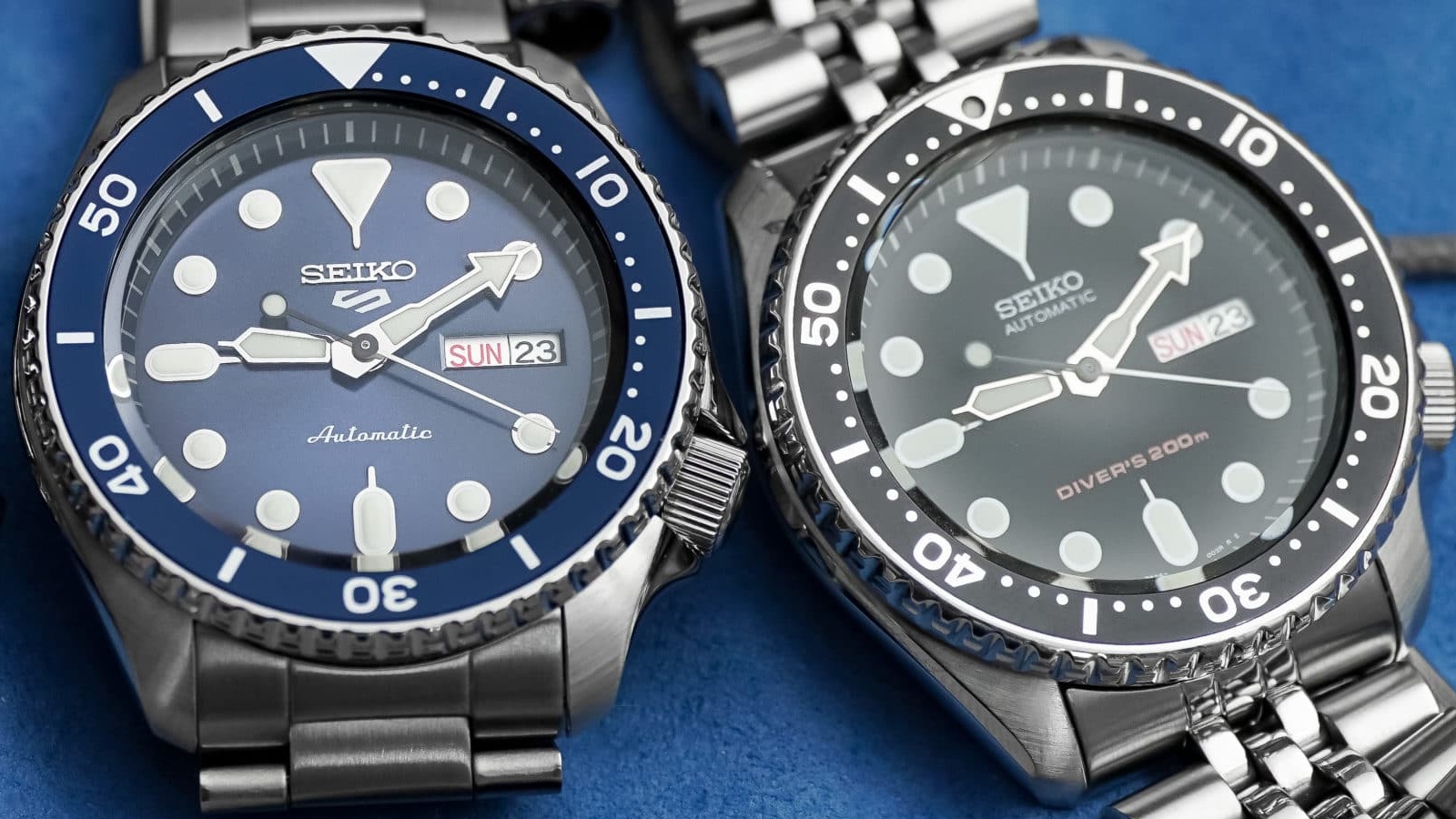
You talk about factory -20/+40 timing like that is acceptable. + 20 to -10 minutes a week is not to me at least. One thing I love about Seiko auto movements properly running is they are easily tuned to one digit numbers. Probably 80% of Seiko watches and movements I have experience with need adjusting for me. The 7S26 movements can be very accurate, same with the 4R35/36 series. I wish Seiko would do better factory timing adjustments but I assume it is cost prohibitive. I have many auto’s and an insane obsession with watches and car engines so a timegrapher was a needed item for me and with several old working pocket watch movements I learned adjusting timing. Very few buyers can do that so I wish Seiko would do better and I think they have with the new 4R35B movement. I was once a snorkel guy and had a Seiko “flying saucer” 6119-6400 in orange that is looking for a stem to work again.
Your article helped me decide to buy the 5 in orange. After 2 months of break in it has come down from +18 s/d to right now on the Weishi it is averaging about +5 s/d. This one will be one of the 20%, LOL. I have many vintage Seiko autos from 60’s up, not a watchmaker but a tuning nut and movement changer.
BTW, just I just received a Presage with the 4R35B movement, over 20 changes from the 4R35A. Not broken in but running +7 s/d out of the box. I hope that will be a new norm, single digits out of the box. I’ll bet my wifes money the Presage will be a sub 5 second watch when broken in, I love it.
Thanks for the article!
Hi, John:
Thanks for reading and for sharing real numbers from your timegrapher. To clarify: when I cited Seiko’s -20/+40 s/d, that was the published factory tolerance, not what I consider “acceptable” performance. It’s essentially the warranty floor. In our own testing, most 7S/4R pieces settle into single-digit gains after a short break-in or a simple regulation (very much like what you saw with your orange 5 going from +18 s/d to ~+5 s/d).
I’m with you that most buyers won’t (and shouldn’t have to) regulate a new watch. Tighter factory adjustment would make a big difference at this price point. Appreciate you taking the time, and enjoy that Presage also I hope you’re able to find a replacement stem for your 6119-6400 flying saucer. That’s such an interesting watch and it’s important to keep it preserved and in working condition for as long as possible.
Thank you for the thoughtful comment!
-Kaz